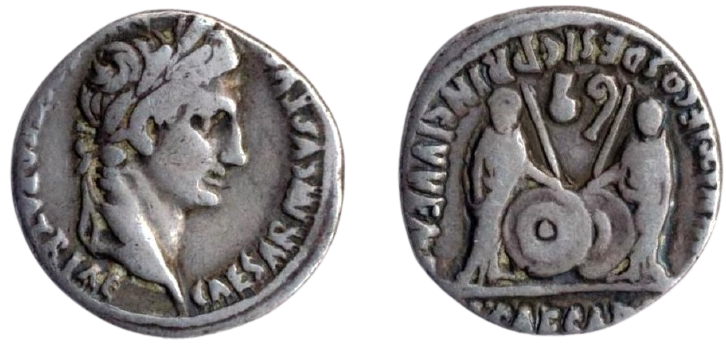
Pedigree: Ex-Auctiones GmbH Auction e-27, Lot 35 (Bern, 15 June 2014)
Album: Sold Coins
Categories: Roman Coins
Tags:

Pedigree: Ex-Auctiones GmbH Auction e-27, Lot 35 (Bern, 15 June 2014)
Album: Sold Coins
Categories: Roman Coins
Tags:
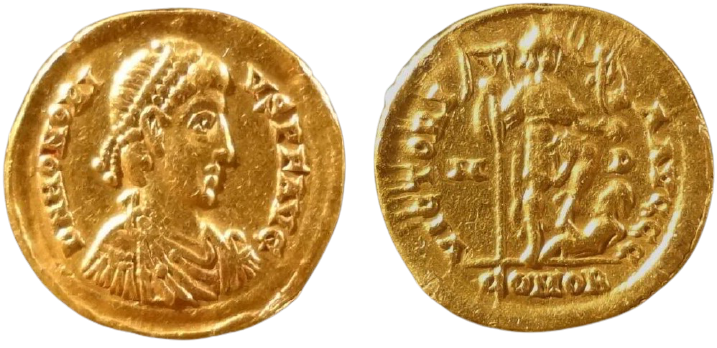
Honorius AV Solidus (4.40g). Mediolanum, c. 395 CE.
Obv: DN HONORIVS PF AVG. Diademed, draped, cuirassed bust of emperor r.
Rev: VICTORIA AVGGG / COMOB / M-D. Emperor standing r. holding standard, stepping on captive.
Ref: RIC 1206; Cohen 44; Sear 20916; Kurth rev. type “d” (see Wildwinds RIC 1206.4 & Dane Kurth’s “Table to assist the identification of Honorius’ […] Solidi of the emperor with captive at foot.”)
Provenance: From the Jackson-Jacobs Collection of “Barbarians, Captives, and Enemies” on Roman Coins; Sold c. 2015; Ex-Aureo y Calico Auction 258 (Barcelona, 20 Mar 2014), Lot 3425.
Notes: See ‘Selections from “BCE Collection”‘ page.
Album: Sold Coins
Categories: Roman Coins
Tags:
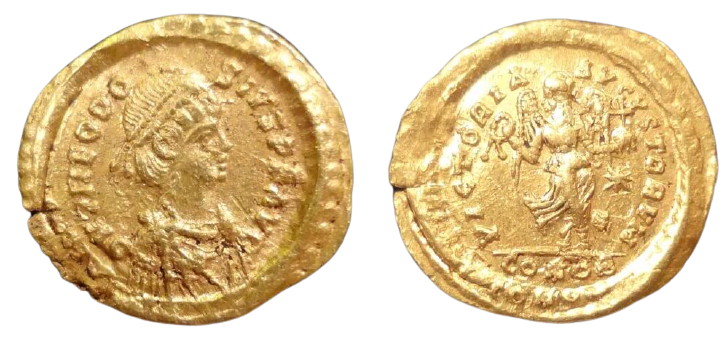
Pedigree: Ex-Gitbud & Naumann Auction 2, 307 (Munich, 7 April 2013)
Theodosius II (AD 402-450) AV Tremissis (1.4g, 15mm, 6h). Constantinople,
Obverse: DN THEODOSIVS PF AVG. Diademed, draped and cuirassed bust right.
Reverse: VICTORIA AVGVSTORVM CONOB.
Victory advancing right, head left, holding wreath and globus cruciger; star to right.
Reference: RIC 213.
Album: Sold Coins
Categories: Roman Coins
Tags:
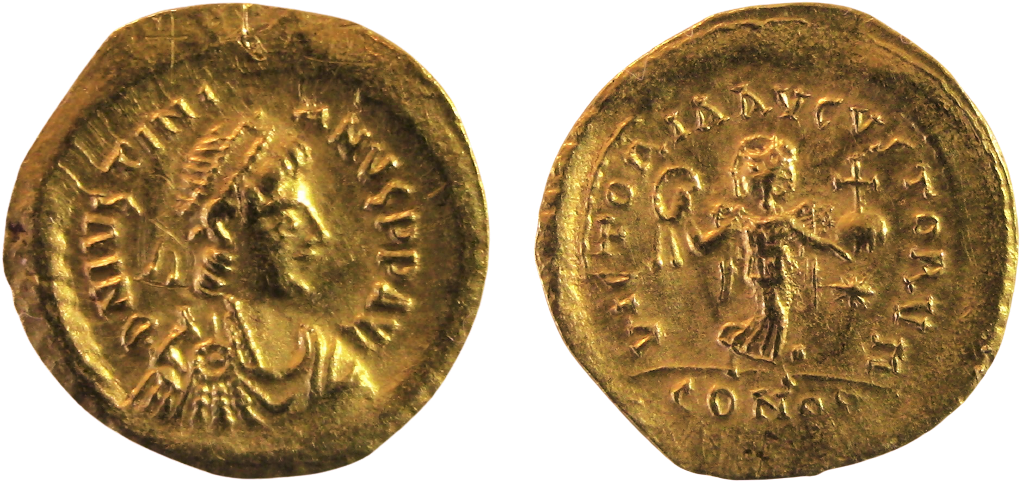
Justinian I “The Great” (527-565) AV Tremissis (1.45g, 17mm, 6h). Constantinople, circa 527-565.
Obverse: DN IVSTINIANVS PP AVG. Diademed, draped, and cuirassed bust right.
Reverse: VICTORIA AVGVSTORVM / CONOB in exergue. Victory advancing right, head left, holding wreath in right hand & globus cruciger in left. Star to right.
References: SB 145; DOC I 19; MIB I 19.
Provenance: Ex-CNG e-Auction 455, Lot 394 (Lancaster, PA 30 Oct 2019), from the Jack A. Frazer collection; Harlan Berk Buy or Bid Sale 27, Lot 8 (13 Sep 1983); includes original inserts from CNG & HJB.
Numis. Notes: Typical slightly wavy flan. Tiny obv. graffito: large “B” between head/legend & crosses (11h, 1h).
Hist. Notes: Representative of shift from Pagan toward Christian symbols on Byzantine coinage (much like Imperial coinage of Constantine). Note, particularly, the figure on the reverse depicted holding a wreath (indicative of Roman deity Victory), but also a globus cruciger (perhaps suggestive of an angel, as on coins of Justin II & later, but clearly referencing Christianity).
The reverse figure is persuasively identified as Victory in the literature, but since the joint reign of Justin I and Justinian (c. 519; see SB [1987] p.14 & 44), an (always male) angel had largely replaced Victory on the AV Solidus. The figure of Victory seems to have been preserved on the Tremissis (sometimes visibly female). One wonders, though, whether and to what extent that shift may have influenced both the design of the Victory-type Tremissi by the mints and their reception by the public.
Album: All Coins
Categories: Byzantine
Tags:
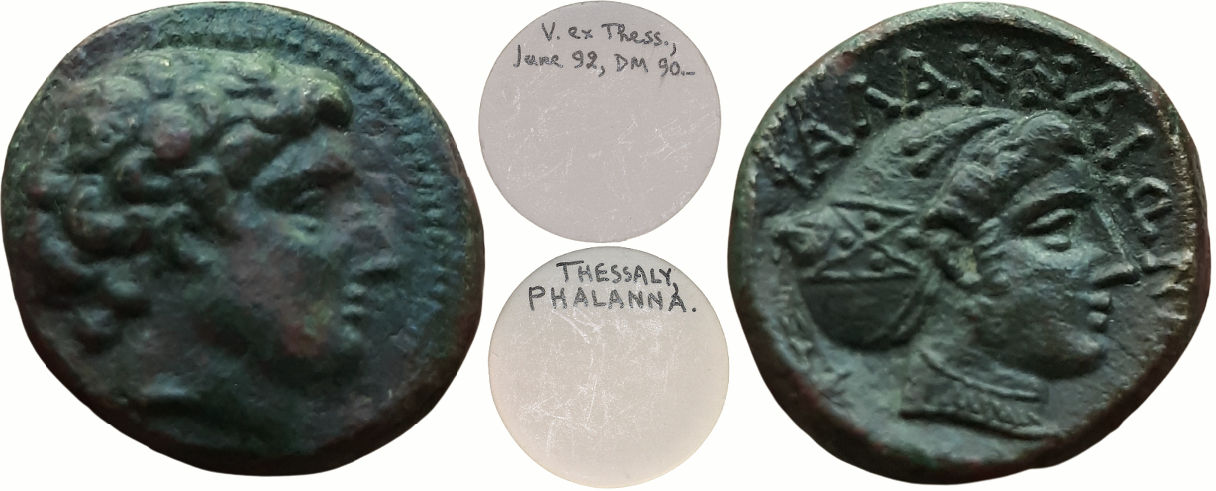
Thessaly, Phalanna AE Dichalkon (18mm, 5.30g, 12h). Mid 4th century BC.
Obverse: Youthful male head right Apollo or Ares?). Border of dots.
Reverse: ΦAΛANNAIΩN (unbroken, 9h to 3h). Head of the nymph Phalanna right, wearing triple pendant earring and necklace, her hair bound in a decorated sakkos tied at the back.
References: BCD Thessaly I 1255.1, II 578, 583.3; Papaevangelou-Genakos 5, 22; Rogers 452; HGC (4) 170, 175.
Pedigree: Ex-BCD Collection (with original hand-written label; acquired 1992); CNG e-Auction 455, Lot 85 (30 Oct 2019). With his hand written tag, “V. ex Thess., June 92, DM 90.” (Purchased in Germany, June 1992?) Other coins from his collection have tags labeled “ex Thess.”, dated 1986 to 1998, preceded by a variety of codes (V., T/ne, S., and others). If the codes have been deciphered, I am unaware.
Numis. Notes: Oval shaped flan, strong green & red patina. Die crack around obv. nose. Very rare with this level of detail.
Struck from dies of exceptional quality. Writing about a coin struck from the same obverse die (Triton XV, Lot 578), BCD himself commented: “The style of this coin is superior to most from the large quantities of similarly sized dichalka that constitute the third and final period of the mint’s output according to Papaevangelou-Genakos. These dies were probably cut by a master engraver and were subsequently copied by lesser artists to the extent and amounts required at the time.”
See also: CNG e-Auction 458, Lot 47 (18 Dec 2019), same obv die struck later.
Album: All Coins
Categories: Greek Coins
Tags:
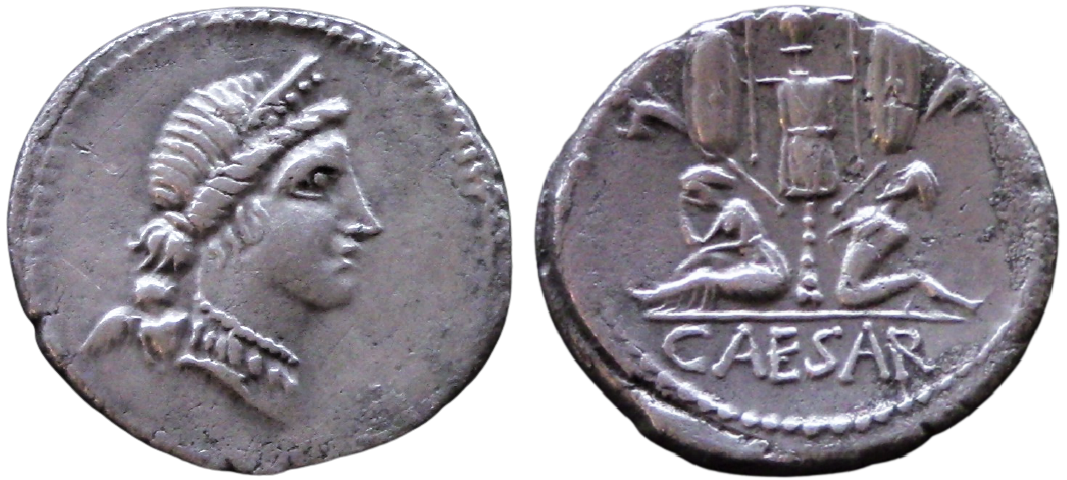
Roman Republican/Imperatorial. Julius Caesar (Dictator, 49-44 BCE). AR Denarius (3.70g, 20mm, 12h). Military mint moving with Caesar in Spain, 46-45 BCE.
Obv: Head of Venus to right, wearing stephane; Cupid behind shoulder
Rev: Trophy of Gallic arms, composed of helmet and cuirass, oval shield and two carnyxes. Two Gallic captives seated at base, to left, a female (Gallia) in posture of mourning, head resting in r. hand; to right, a bearded male (Vercingetorix) with hands bound behind him, looking l. CAESAR in exergue.
Reference: Crawford 468/1; CRI 58; RSC 13; Sydenham 1014.
Provenance: Ex-Tauler y Fau Substastas Auction 70, Lot 79 (Madrid, 24 Nov 2020), with export license from Spain.
Video of this coin is available here.
Numismatic Notes: The figures on the reverse of this coin are traditionally identified as the same as those portrayed on the obverses of the pair of Hostilius Saserna AR Denarii, c. 48 BCE, depicting Gallia (left) and Vercingetorix (right).
This coin became the archetype for Roman numismatic depictions of captives for the next 400 years (gallery of selected Barbarians, Captives, Enemies). The trophy with two captives beneath was used frequently in the 3rd century (e.g., by Septimius Severus and Caracalla) and became a popular type on 4th century small bronze coinage (see, e.g., the Constantine AE3s). Even those depicting a single captive borrowed from this imagery; e.g., Judaea (under Vespasian et al.), Armenia (L. Verus et al.), and Dacia (Trajan et al.), among others, were depicted as female personifications in the same attitude of dejection/posture of mourning.
Album: All Coins
Categories: Roman Coins
Tags:
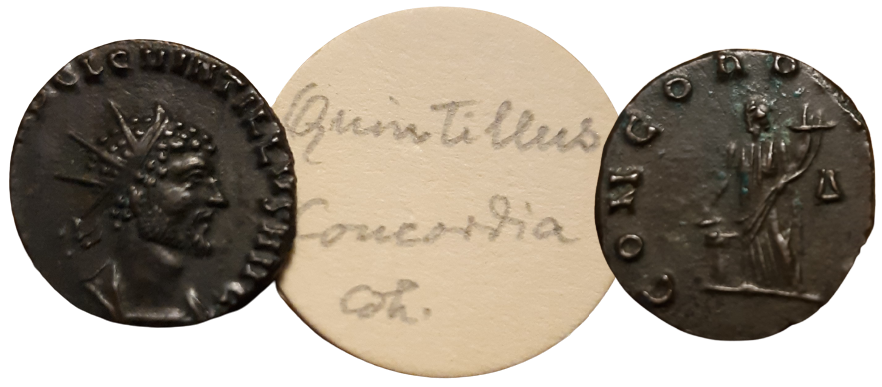
* Return to “Provenance Glossary” Page (to Private Collections)
Quintillus Billon Antoniniaus (2.68g, 17.5mm, 12h). Rome mint, 270 CE.
Obverse: IMP C M AVR QVINTILLVS AVG. Radiate and draped bust right.
Reverse: CONCORDIA AVG / Δ to right. Concordia standing left, sacrificing over altar & holding double cornucopiae.
Reference: RIC 13; Cohen 17.
Provenance: Ex-Ancient & Medieval Coins Canada Auction 2 (9 Nov 2019), Lot 210, from the “Orfew”/Andrew Short Collection; Naville Numismatics Auction 35 (London, Online, 29 Oct 2017), Lot 717, from the E.E. Clain-Stefanelli Collection (1914-2001; Curator, National Numismatic Collection, Smithsonian), incl. her hand-written tag w/ notes.
Numis./Hist. Notes: The brief reign of Quintillus lasted only weeks or months in 270 CE. That he produced coins at all – in fact, a considerable number of issues in AE, billon and gold, including those at Provincial mints – despite reigning for as little as a few weeks, provides strong evidence of how important coin production was to Emperors to quickly legitimize and publicize their rule, as well as evidence of how efficient the process was.
Provenance Notes: Elvira “E.E.” Clain-Stefanelli (her husband, Victor, also a numismatist, is known as “V.E.”) was a curator, then Executive Director of the National Numismatic Collection at the Smithsonian, 1956-2001. She is known for bringing the national coin collection from provincial backwater to world-class status.
A famous numismatist, her obituary was published in 2001 in the Washington Post. Her wikipedia entry.
The Clain-Stefanelli Collection (begun by Vladimir in the 1930s, assembled together until his death, continued by Elvira until at least the early 1990s), was auctioned by Stack’s (“Demarete Collection”) and then Numismatica Ars Classica and their affiliated auctioneer, Naville Numismatics (London). Naville sold this coin to “Orfew” (online handle of collector subsequently named in CNG sales as the applied linguist Andrew Short); from there it was consigned to Ancient & Medical Coins Canada, from which it joined the Jackson-Jacobs Collection.
Album: All Coins
Categories: Roman Coins
Tags:
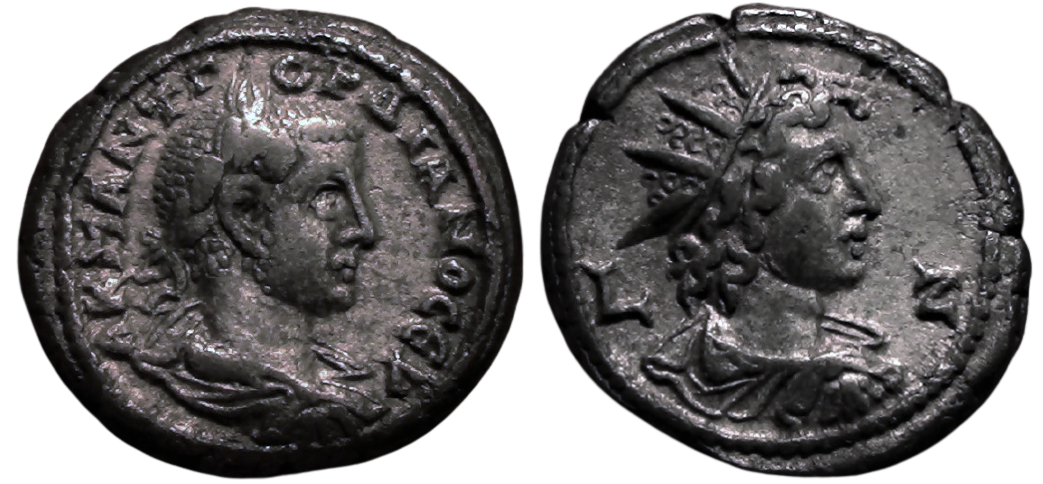
A splendid Alexandrian Tetradrachm of Gordian III (Emperor, 238-244 AD), notable for its rarity, important pedigree, and being illustrated in important reference volumes.
Full writeup & video of this coin available here.
Roman Provincial. Gordian III (238-244). Billon Tetradrachm (23mm., 12.35g, 12h). Struck in Egypt, Alexandria, 243-4 AD.
Obverse: Α Κ Μ ΑΝΤ ΓΟΡΔΙΑΝΟϹ ƐΥ (see Numis. Notes below). Laureate, draped & cuirassed bust of Gordian right, seen from behind.
Reverse: Bust of Helios facing right, radiate & draped, seen from behind. In fields, L-Z (Regnal Year 7).
References: Dattari 4731 (this coin, not illustrated); Dattari-Savio plate 252, 4731 (this coin illustrated); RPC VII.2 (in press) 3669.9 (this coin illustrated); RPC Online Temp. 3037 (this coin illustrated, #11417); Milne 3466; BMC Alexandria 1859; Emmett 3407; K & G 72.137.
Pedigree: Ex-Naville Numismatics (London) Auction 60, #308; from the Dattari collection, formed before 1901.
Album: All Coins
Categories: Provincial Roman Coins
Tags:
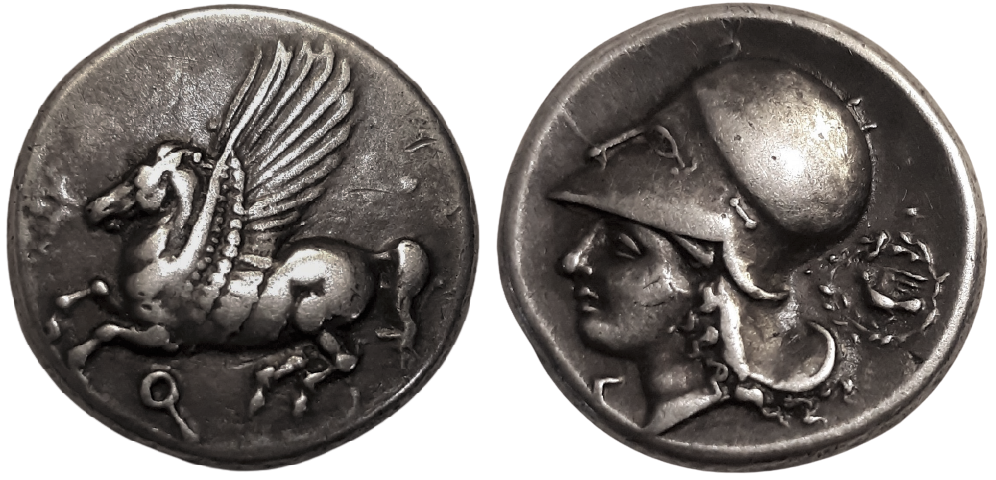
Corinth, Corinthia. AR Stater (8.52g, 21mm, 9h). Struck circa 345 – 305 BCE
Video of this coin available here
Obverse: Pegasos flying right, Ϙ symbol below.
Reverse: Head of Athena left, wearing Corinthian helmet. Γ below chin, dove within wreath.
References: Ravel 1029; Calciati Pegasi 419; BCD Corinth 110; SNG Lockett 2094.
Provenance: Ex Prof. Samuel-Jean Pozzi (1846-1918) Collection, sold at Naville et Cie (Lucerne, 14 March 1921), Catalogue de Monnaies Grecques Antiques Provenant de la Collection de feu le Prof. S. Pozzi, Lot 1688 (Hammer, Sfr 17). Published in Boutin’s 1979 catalog of the collection, No. 3756.
Privately purchased from Anthony “Tony” Tumonis at Halden Birt’s Glass Shoppe Coins (Tucson, AZ, circa 1991-2).
Notes: One of the scarcer reverse dies for this type but, in my view, an especially expressive and lifelike Athena. Dark old cabinet tone. Well centered. Among the favorites of collection.
Hist. Notes: Dr. Samuel-Jean Pozzi (1846-1918) was a celebrated French gynecologist whose life was cut short when a disgruntled patient murdered him. He had been assembling one of the world’s finest private collections of Greek coins for 25 years.
The Pozzi Collection was cataloged for the first sale by Naville et Cie in 1921. During the early 20th century “golden age” of ancient coin catalogs, the Pozzi catalog set the standard, illustrating every lot and providing weights to 0.01g — a level of completeness previously unthinkable. For decades, it was a standard reference for Greek coinage by scholars, dealers, and collectors.
Alan S. Walker described it as “very possibly the best known and most famous auction catalogue of Greek coins ever produced” (2008, AJN, p. 604). For this reason, as Harlan J. Berk commented, “The Pozzi pedigree is one of the most revered in numismatics” (Berk 2004, BBS 190).
Bibliographic: Further references for the Pozzi Sale: Clain-Stefanelli 1988*; Daehn 2084; Grierson, p. 296; Kroh, p 11 (four stars); Spring 471, “Most important sales of ancient Greek coins.” References for the Boutin (1979) catalog: Clain-Stefanelli 1932*; Daehn 2031.
Album: All Coins
Categories: Greek Coins
Tags:
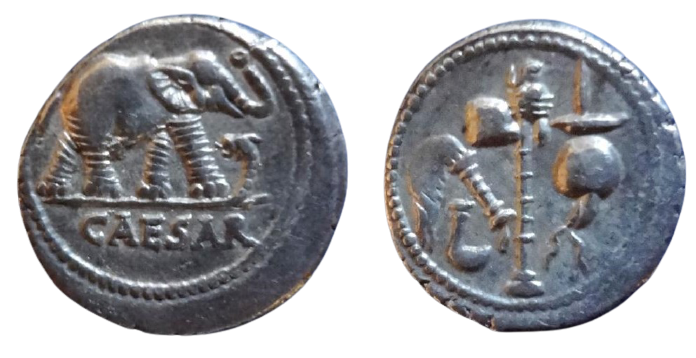
For more information on this type, see our writeup on the Julius Caesar Elephant Denarius
Julius Caesar (Dictator, 49 – 44 BC) AR Denarius (3.85g, 18mm, 4h). Mobile military mint traveling with Caesar in Northern Italy, 49 BC.
Obv: Elephant advancing right, trampling on horned serpent or carnyx (Gallic war trumpet). CAESAR in exergue.
Rev: Pontifical emblems – ladle (simpulum), sprinkler (aspergillum), axe (securis) surmounted by a wolf head, and priest’s hat (apex).
Ref: RSC 49; Crawford 443/1; Sydenham 1006; Sear CRI 9; Babelon 1885, p10, Julia 9.
Pedigree: Ex-Roma Numismatics E-Sale 9, Lot 392 (London, 28 June 2014)
Album: Sold Coins
Categories: Roman Coins
Tags: